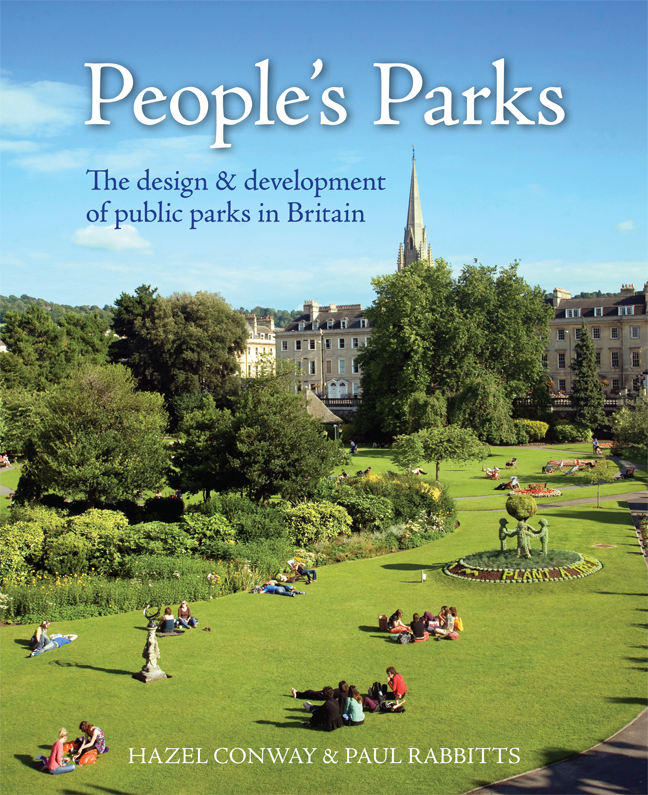Book contents
- Frontmatter
- Dedication
- Contents
- Miscellaneous Frontmatter
- Preface
- Acknowledgements
- Foreword
- A Word from Parks Professionals, Politicians and Parks Organisations
- Introduction: Dr Hazel Conway (1991)
- 1 Public Parks and Municipal Parks
- 2 The Need for Parks
- 3 Pioneering Parks Development
- 4 The Park Movement
- 5 Design and Designers
- 6 Lodges, Bandstands and the Cultivation of Virtue
- 7 Local Pride and Patriotism
- 8 Planting and Park Maintenance
- 9 Permitted Pastimes
- 10 Recreation Grounds, Parks and the Urban Environment
- 11 Public Parks, 1885–1914
- 12 Later Municipal Park Designers
- 13 Garden Cities and the New Towns Movement
- 14 Sport, Physical Activity and Recreation in Public Parks in the Inter-war Years
- 15 Parks Management – a Changing Perspective
- 16 Decline, Revival and Renewal – the Role of Parks into 21st-century Britain
- Appendix 1 Summary of main legislation promoting early park development
- Appendix 2 Chronology of main municipal and public park developments between 1800 and 1885
- Notes
- Bibliography
- Subscription List
- Index
12 - Later Municipal Park Designers
Published online by Cambridge University Press: 22 February 2024
- Frontmatter
- Dedication
- Contents
- Miscellaneous Frontmatter
- Preface
- Acknowledgements
- Foreword
- A Word from Parks Professionals, Politicians and Parks Organisations
- Introduction: Dr Hazel Conway (1991)
- 1 Public Parks and Municipal Parks
- 2 The Need for Parks
- 3 Pioneering Parks Development
- 4 The Park Movement
- 5 Design and Designers
- 6 Lodges, Bandstands and the Cultivation of Virtue
- 7 Local Pride and Patriotism
- 8 Planting and Park Maintenance
- 9 Permitted Pastimes
- 10 Recreation Grounds, Parks and the Urban Environment
- 11 Public Parks, 1885–1914
- 12 Later Municipal Park Designers
- 13 Garden Cities and the New Towns Movement
- 14 Sport, Physical Activity and Recreation in Public Parks in the Inter-war Years
- 15 Parks Management – a Changing Perspective
- 16 Decline, Revival and Renewal – the Role of Parks into 21st-century Britain
- Appendix 1 Summary of main legislation promoting early park development
- Appendix 2 Chronology of main municipal and public park developments between 1800 and 1885
- Notes
- Bibliography
- Subscription List
- Index
Summary
The early park designers included Paxton, Loudon, Milner and Pennethorne as well as other notable architects. Towards the end of the 19th century and the early part of the 20th century, many of the parks were designed and laid out by a number of individuals that included landscape architects and gardeners, and nurserymen, as well as park superintendents, who were also responsible for the establishment of early iterations of the parks department.
The park designers
Competitions were popular as a way of obtaining schemes for new parks, and attracted entries particularly from professional designers and nursery firms. The Gardeners’ Chronicle of 1890 thought the success of many recent schemes was a result of the prevailing custom of offering prizes for the best designs for laying out parks, the keen competition having had a stimulating influence on the landscape architect. The Builder commended Wrexham on holding a competition for the design of its new park rather than calling in the local landscape gardener, but suggested that in the case of a public competition, an assessor of wider experience than the park superintendent might have been appointed. The response to the Liverpool competition, held in 1914, showed that by this time there was a considerable amount of ability in park design present in the country. It was suggested by The Builder, which reviewed the competition, that other municipalities should follow the example set and either engage a park expert or hold a competition in the hopes that this might result in ‘fewer of those deplorable attempts at public parks with which we are so familiar in English towns’. Thomas Hayton Mawson (1861–1933), in a lecture to the Town Planning Conference of 1910, had made similar disparaging comments on the nation's success at park making. The problem, he felt, lay at the initial stages of the park's life: ‘our public parks, which contrast so unfavourably with our private gardens, are almost entirely the work of amateurs’. Whether or not this was true depends rather on one's definition of the word ‘amateur’.
Landscape gardeners and designers
A number of individuals and firms specialised in the layout of public parks. Mawson has been described as ‘probably the most successful designer of parks in the first quarter of this century’ and ‘the leading park designer’ of the period covered by this study.
- Type
- Chapter
- Information
- People's ParksThe design & development of public parks in Britain, pp. 191 - 216Publisher: Boydell & BrewerPrint publication year: 2023

